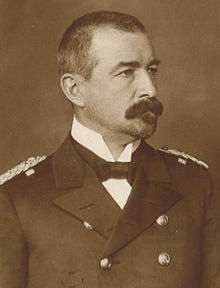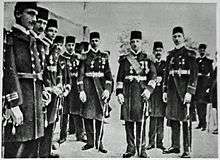Wilhelm Souchon
| Wilhelm Souchon | |
|---|---|
 Admiral Souchon | |
| Born |
June 2, 1864 Leipzig, Kingdom of Saxony |
| Died |
January 13, 1946 (aged 81) Bremen, Germany |
| Allegiance |
|
| Service/branch |
|
| Years of service | 1881–1919 |
| Rank | Vice Admiral |
| Commands held | Mittelmeerdivision |
| Battles/wars |
|
| Awards | Pour le Mérite |
| Relations | Hermann Souchon |
Wilhelm Anton Souchon (German pronunciation: [suˈʃɔŋ]; 2 June 1864 – 13 January 1946) was a German-born Ottoman Admiral in World War I. Souchon commanded the Kaiserliche Marine's Mediterranean squadron in the early days of the war. His initiative played a major part in the entry of the Ottoman Empire into World War I.
Biography
Wilhelm Anton Souchon was born on 2 June 1864 in Germany to a family of Huguenot ancestry.[1]
In July 1914, hostilities erupted between the Austro-Hungarian Empire and the Kingdom of Serbia. Rear Admiral Souchon, a native of Leipzig, feared being trapped in the Adriatic Sea in the event of other nations joining in the conflict. Because of this, Souchon took his two ships, the battlecruiser Goeben and the light cruiser Breslau, into the western Mediterranean. When World War I began on 4 August 1914, he bombarded the French-Algerian ports of Bône and Philippeville. He successfully eluded British attempts to corner him (see Pursuit of Goeben and Breslau) and on 10 August 1914, his small squadron arrived at the Dardanelles.

After two days of negotiations, he was allowed to take his ships to Istanbul where they were subsequently transferred officially into the Ottoman Navy. Souchon was appointed Commander-in-Chief of the Ottoman Navy and served in this position until September 1917. This gesture by Germany had an enormously positive impact with the Turkish population. At the outbreak of the war, Winston Churchill caused outrage when he "requisitioned" without compensation two almost completed Turkish battleships in British shipyards, Sultan Osman I and Reshadieh, that had been financed by public subscription. These ships were commissioned into the Royal Navy as Agincourt and Erin, respectively. On 15 August 1914, in the aftermath of Souchon's daring dash to Constantinople, Turkey cancelled their maritime agreement with Britain and the Royal Navy mission under Admiral Limpus, and left by 15 September.
The Dardanelles were fortified with German assistance and the Bosporus was secured by the presence of Goeben (now Yavuz Sultan Selim). On 27 September 1914, the Straits were officially closed to all international shipping.
On 29 October 1914, Souchon's fleet launched the Black Sea Raid, a naval attack which brought the Ottoman Empire into World War I. His ships laid several sea minefields and shelled the Russian Black Sea ports of Sevastopol, Odessa, and others, destroying the Russian minesweeper, Prut, in the process. British naval units quickly retaliated on Turkish merchant ships off İzmir. On 2 November 1914, Russia declared war on the Ottoman Empire. On 5 November, Britain followed suit and on 12 November 1914, the Ottoman government officially declared war on the Triple Entente.
For the next three years, Souchon attempted to reform the Ottoman Navy while conducting a number of raids on Russian shipping, ports, and coastal installations in the Black Sea. Promoted to Vice Admiral, Souchon was awarded the Pour le Mérite, Germany's highest military order, on 29 October 1916.
In September 1917, Souchon returned to Germany. There he received command of the Fourth Battleship Squadron of the High Seas Fleet during Operation Albion. By the end of the war, he was commanding officer of the Imperial Navy base at Kiel.
At the out break of the Kiel mutiny on 3 November 1918, Souchon asked for outside troops, but revoked his request for military help when his staff claimed the situation was under control. Souchon had been deployed to Kiel a few days earlier on 30 October 1918, and had therefore to rely heavily on his staff. On 4 November, the request had to be renewed. Altogether six infantry companies were brought to Kiel. Some units stayed in the city quarter Wik, and in the Marinestation der Ostsee. However, these troops showed signs of disintegration and some joined the revolutionaries. Souchon had to negotiate and order the withdrawal of the units.[2] In the course of the events, Souchon stepped down as Governor and was replaced by the civilian social democratic politician, Gustav Noske.
Admiral Souchon died in Bremen on 13 January 1946.
Legacy
Souchon's nephew, Hermann Souchon (1894–1982), was the assassin of Rosa Luxemburg.[3]
References
- ↑ Henry Morgenthau. "Ambassador Morgenthau's Story. 1918. Chapter Eight". net.lib.byu.edu. Retrieved 21 September 2016.
- ↑ Dirk Dähnhardt: Revolution in Kiel. Neumünster 1978, S. 83 f.
- ↑ "ZEITGESCHICHTE LIEBKNECHT -- LUXEMBURG: Der dritte Mann - DER SPIEGEL 8/1967". Spiegel Online (in German). 13 February 1967. Retrieved 21 September 2016.
External links
| Wikimedia Commons has media related to Wilhelm Anton Souchon. |